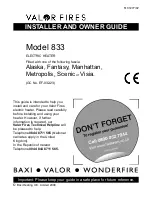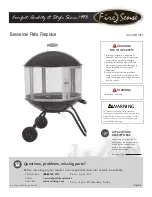
17
OPERATION
To switch ON the heater
•
Switch the fused isolator switch ON (supply
customer)
•
Switch the heater ON/OFF selector to “ON”
•
Turn the thermostat to the desired temperature
•
The heater will start automatically
To switch OFF the heater
•
Turn the thermostat to its lowest temperature setting
or alternatively switch the heater ON/OFF selector
switch to OFF
•
The burner will switch off but the fan will continue to
operate for 3 to 4 minutes to cool the combustion
chamber before stopping
•
Finally switch the fused isolator to OFF
To switch ON fan only
•
Switch the fused isolator to ON
•
Set ON/STANDBY switch to ON
•
Set VENT/HEAT switch to VENT position
•
The fan only will run
To switch OFF fan
•
Set ON/STANDBY switch to STANDBY
Stop
•
Turn the selector switch to STOP
IF HEATER IS TO BE SWITCHED OFF FOR A LONG
PERIOD
•
Set ON/STANDBY switch to STANDBY
•
Isolate at mains electrical supply
•
Isolate the gas supply
WARNING!
UNLESS IN AN EMERGENCY
Never stop the heater by switching off at the mains
isolator. The residual heat accumulated in the heat
exchanger may trigger the LIMIT safety device
resulting in the need to reset manually.
If this is repeated it will damage the heat exchanger
and will invalidate the warranty on the heater.
VERSION SINGLE STAGE
In the single stage version the heater has a standard maximum heat output and a fixed air flow capacity the heater can
be operated manually via a switch or automatically by a remote thermostat.
VERSION TWO STAGE
In the two stage version the heater has a two stage high low gas valve and can be operated in either high fire or low fire
but with a fixed air flow capacity the heater can be operated manually via a switch or automatically via a remote
thermostat.
SERVICING
•
Switch the fused isolator switch ON (supply
•
Turn the thermostat to its lowest temperature setting
or alternativly switch the heater ON/OFF
•
The burner will switch off but the fan will continue to
operate for 3 to 4 minutes to cool the heater.
WARNING!
It is a requirement that only qualified personnel are
allowed to carry out installation commissioning or
servicing. In addition only spare parts recommended by
the manufacturer may be fitted, and the installer should
provide a list of recommended spare parts that are
available through the manufacturer or his agent.
Before commencing any maintenance or servicing work
the heater must be shut down and allowed to cool, and
have the gas and electric supplies to it turned off at the
supply cock and isolator respectively.
Always test for gas soundness after completing any
service work particularly if this has necessitated
the removal and / or replacement of gas carrying
components
It is advisable that routine inspections are carried out on
a frequent basis, servicing must also be carried out
regularly, and in accordance with the manufacturers
recommendations i.e. at a maximum interval of one
year. In certain applications the frequency of servicing
will have to be increased, this to a large extent is
governed by the working environment, and both the
manufacturer and the installer will be able to offer
further advice.
A safe working platform giving good access to the
heater is required.
Clean all accessible surfaces including the outside of
the heat exchanger by removal of the fan assembly and
the louvres. Check for panel damage and that all
fasteners are present and secure.
Visually check all electrical wiring for signs of damage,
possibly through contact with hot surfaces, check
conduit for signs of chaffing and for security . Check all
terminals are secure and free from escaped / stray
conductor strands
CLEAN EXTERNAL PANELS
This cleaning should only be carried out with damp
cloths with soap and water. In If there are stubborn
stains dampen The cloth with a 50% mixture of water
and white spirit.
After cleaning dry the surfaces carefully.
CLEANING
Filters should be cleaned regularly as required.
















































